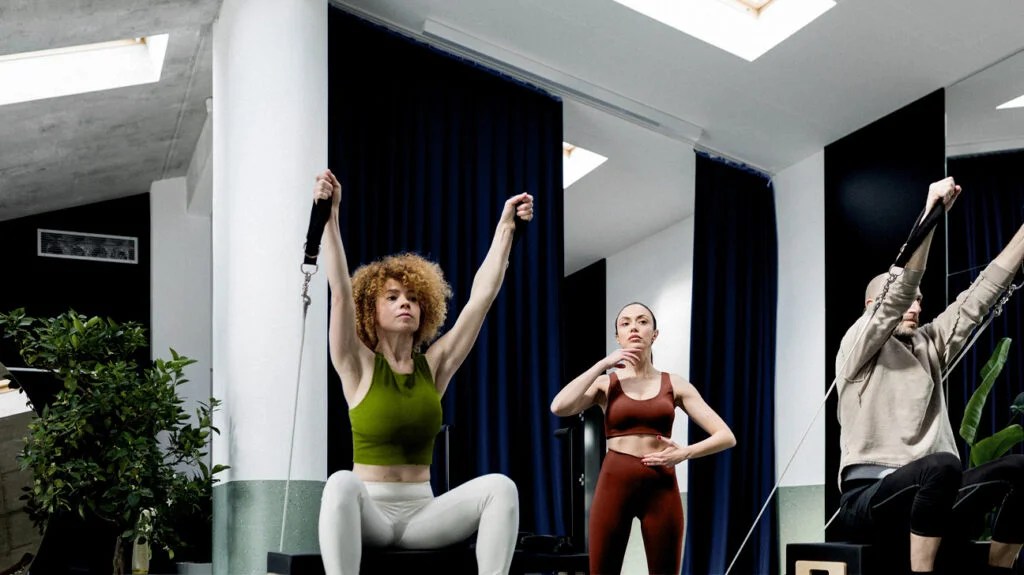Pilates is a type of workout that involves simple, repetitive exercises that increase muscle strength, endurance, flexibility, and postural stability. It is relatively safe and accessible for beginners.
Joseph Pilates developed Pilates and introduced the exercise method to the United States in
Research suggests that Pilates offers several health benefits. For example, a
To get started, all a person needs is a mat and instructions.
This article defines Pilates and discusses its benefits. It also compares it with yoga, tells how to get started, and lists resources.

After introducing his physical and mental conditioning to soldiers overseas during World War I, Joseph Pilates brought the exercise program to the United States.
The Pilates program consists of 50 repetitive, simple exercises that involve muscle exertion. A person can adapt it to provide either gentle strength training for rehabilitation or a vigorous workout for athletes.
The exercise program aims to improve:
- endurance
- muscle strength and activity
- flexibility
- abdominal and lumbopelvic stability, which refers to the trunk and lower back
Exercises in Pilates use breathing in a strategic way. The combination of controlled movement and breathing can improve the following:
- cervical (neck) alignment
- scapular (shoulder blade) stabilization
- use of the transversus abdominis, a muscle that wraps around the trunk and provides postural support
- pelvic mobility
Benefits may include the following:
Reduction in pain
A
It found the program effective for producing desired outcomes, especially for decreasing disability and pain.
The authors urged further research to assess Pilates for specific health conditions.
Improvement in quality of life
Later research dealt exclusively with a specific age group.
The
Weight loss
A
The results indicated that it dramatically decreased body fat percentages, body weight, and body mass index in individuals with overweight or obesity. However, it had no significant effect on waist circumference or lean body mass.
Increase in balance
A
While Pilates can be challenging, it is adaptable to different skill levels. This means that a person can make their exercise routine as easy or as hard as they want. They can also gradually increase the difficulty over time.
Anecdotal evidence suggests that it is appropriate for people of all fitness levels.
However, a person should always check with a doctor before starting any type of exercise program that differs from their usual activity.
There are significant differences between Pilates and yoga. While Pilates dates back to WWI, yoga
Pilates endeavors to attain full control of behavior via mind-body coordination, but yoga aims to integrate the mind, body, and spirit.
In the United States, the practice of yoga
Studies suggest that the benefits of yoga include:
- relieving stress
- promoting better sleep
- reducing certain types of pain
Results of comparison studies
Scientists have conducted very little research comparing the efficacy of yoga and Pilates. However, there are some existing studies on the topic.
A
- balance confidence
- walking speed
- quality of life
A
To get started, all someone needs is a mat and instructions. YouTube videos led by qualified Pilates instructors are also useful tools for beginners and can help teach proper form.
Below are a few examples of the exercises:
Pilates curl
To perform a Pilates curl, a person should follow these steps:
- Lie on the back with knees bent, arms at the sides, and feet flat on the floor.
- Breathe out, curling the chin to the chest and bringing the shoulders off the mat.
- Hold for a moment, and then lower back down to the mat slowly.
- Lift from the chest to use the abdominal muscles and avoid crunching the neck.
Single-leg stretch
To perform a single-leg stretch, a person should follow these steps:
- Lie on the back, with knees drawn toward the chest and shins parallel to the floor.
- Lift the head, neck, and shoulders off the mat.
- At the same time, extend the left leg to a 45-degree angle and pull the right knee in toward the chest.
- Grab the right knee with the left hand and the right ankle with the right hand.
- Change legs while breathing in. This time, grab the left knee with the right hand and the left ankle with the left hand.
- Change legs again. Keep the shoulders off the mat.
Shoulder bridge
To perform a shoulder bridge, a person should follow these steps:
- Lie on the back with knees bent, arms at the sides, and feet flat on the mat.
- Breathe out and lift the hips off the mat.
- Hold this position while extending the right leg and lifting it upward.
- Bend the right knee and then lower the leg to the starting position.
- Repeat three times, alternating legs.
- Bring hips down to the mat to the starting position.
If someone is looking for an in-person class, they can do a web search for Pilates classes in their area. Otherwise, they may enroll in an online class.
Many websites for Pilates offer a free trial for a certain number of days. Below are some examples:
- Pilates Anytime: 15-day free trial
- Pilates-ology: 14-day free trial
- Move Wellness: 14-day free trial
Pilates involves simple exercises to increase muscle strength, flexibility, and postural stability. Studies suggest that it may offer benefits such as reducing pain and disability.
People can adapt a Pilates routine to their level, so it is suitable for most individuals. It is a good idea to first ask a doctor if Pilates is a suitable exercise program.
